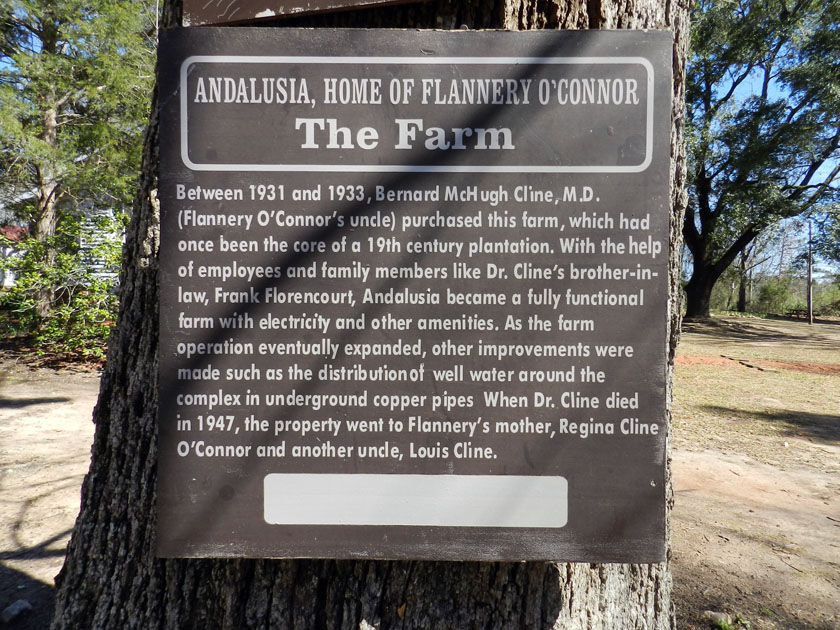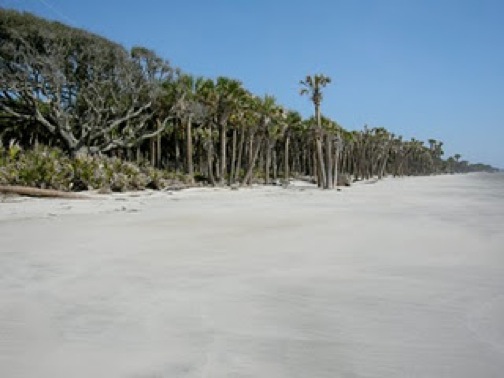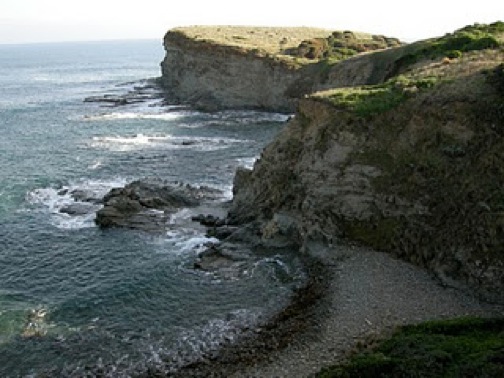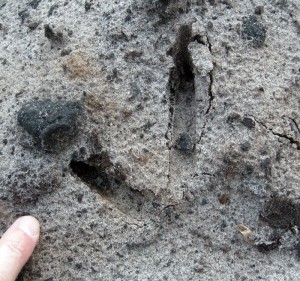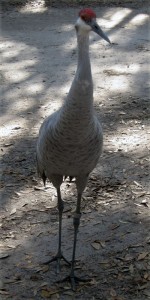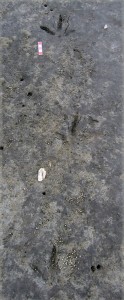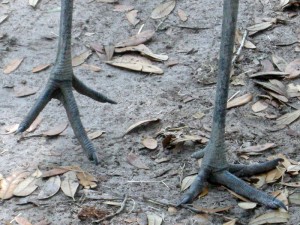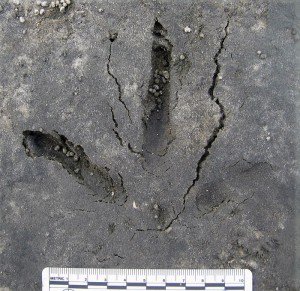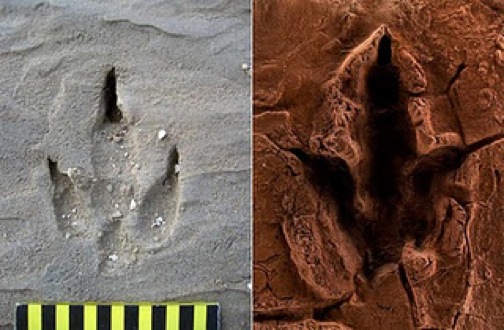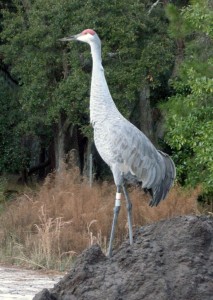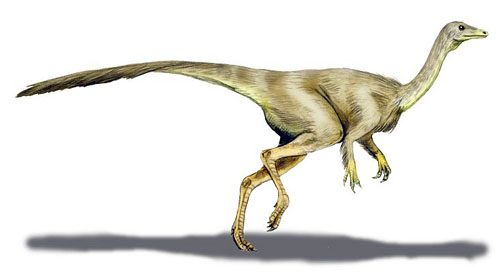Authors of books are sometimes lucky enough to get people interested enough in both them and their books. Even better, these authors are sometimes invited to talk about their books to a receptive audience. Yet I’ll bet few authors get the opportunity to talk about their books with fellow book lovers while also standing on the front porch of a great American author. Even less probable is that the author of a natural history book – one related to paleontology, no less – would somehow have to relate his or her work to a deceased author best known for her Southern Gothic fiction.
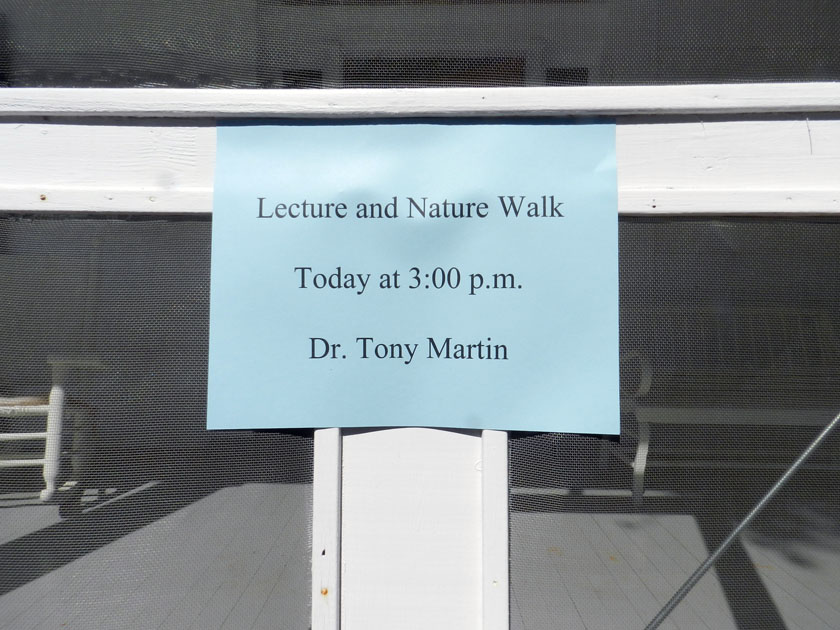 It’s a sign! Upon my arrival at Andalusia Farm, the former home of Flannery O’Connor, this sign greeted me at the door, reminding me why I was there. It was fun to think that during Flannery O’Connor’s life, this is how she might have announced a lecture at her place, using a sheet of paper with words, posted on her door. (For the sake of imagination, just ignore that the notice was created and printed by person using a couple of 21st century devices.) Photograph by Anthony Martin.
It’s a sign! Upon my arrival at Andalusia Farm, the former home of Flannery O’Connor, this sign greeted me at the door, reminding me why I was there. It was fun to think that during Flannery O’Connor’s life, this is how she might have announced a lecture at her place, using a sheet of paper with words, posted on her door. (For the sake of imagination, just ignore that the notice was created and printed by person using a couple of 21st century devices.) Photograph by Anthony Martin.
This past Sunday, I was just so fortunate and challenged, having been invited to speak about my new book, Life Traces of the Georgia Coast, at Andalusia Farm, the former home of famed American writer Flannery O’Connor. Andalusia is located just north of Milledgeville, Georgia, and despite many previous trips to Milledgeville, this was my first visit to Flannery O’Connor’s former haunts. The house and grounds are in a formerly rural setting, its clay-laden driveway just off a busy highway and directly across from a chain hotel. Yet her house is still surrounded by more than 500 acres of forest, streams, and a pond; the pond is visible from the front porch of the house. These natural areas are what attracted me to coming, and provided an avenue for connecting themes of my book with this place.
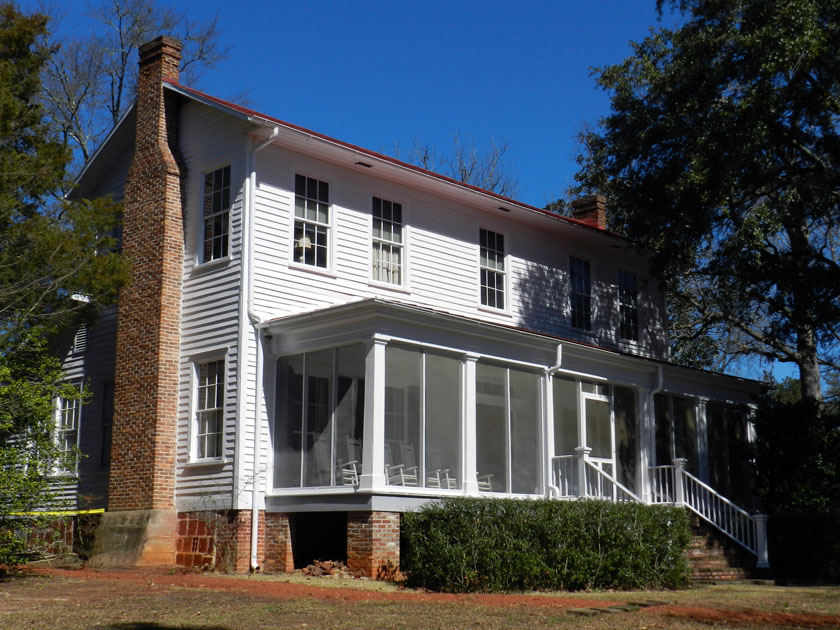 A view of the main house at Andalusia Farm, where Flannery O’Connor spent more than a third of her life. Her bedroom, where much of her writing also happened, is just to the left after passing through the front porch. Photograph by Anthony Martin.
A view of the main house at Andalusia Farm, where Flannery O’Connor spent more than a third of her life. Her bedroom, where much of her writing also happened, is just to the left after passing through the front porch. Photograph by Anthony Martin.
A sign telling about the recent history of Andalusia. Sadly, it does not include any mention of the Alleghanian Orogeny that contributed to the Piedmont Province there, nor does it inform visitors about the maximum extent of the Cretaceous and Eocene seaways just to the south, nor does it acknowledge the former presence and effects of the Pleistocene megafauna that used to live there. But I suppose all of that would have required a much bigger sign. Photograph by Anthony Martin.
O’Connor is much revered in the Southern U.S. and elsewhere, a loyalty that stems partly from the fact that she was indeed a terrific writer of Southern-inspired literature – consisting of short stories, novels, and essays – and partly from a wistful longing of “If only”: namely, if only she had lived longer. Born in Savannah, Georgia in 1925, she traveled to what was then called State University of Iowa (now the University of Iowa), where she earned an MFA, and soon afterwards began her illustrious writing career. In 1951, she was diagnosed with the same disease (lupus) that killed her father while he was still relatively young. She lived with this debilitating condition for the next 14 years, the last 12 of which were at Andalusia. She was only 39 years old when she died in 1964.
So how did I become a character in a Flannery O’Connor story? I blame it all on a paleobotanist friend of mine at nearby Georgia College and State University, Dr. Melanie DeVore, who suggested to me several years ago that I come to speak at Andalusia about my upcoming book. “Why?” was my first response. After all, as a long-time resident of Georgia, I was embarrassed to admit that I had read very little of O’Connor’s works until just recently. I also could not figure out how the plant and animal traces of the Georgia barrier islands could be related to a Southern author whose home was just above the fall line, between the Piedmont and Coastal Plain provinces of Georgia. Even the Cretaceous seaway from 70 million years past had not washed onto the landscape of O’Connor’s home. Thus I felt hard-pressed to come up with a way for my book to be relevant to her literary contributions and a sense of place.
Still, Melanie continued to encourage me to think about it. Admirably enough, she was trying to find ways in which natural scientists might contribute their perspectives to the considerable scholarship behind O’Connor’s works and the popular appeal of her former home. So I delved into O’Connor’s biographies, and searched for an ichnological connection between what she did and my interests. This is when I found the key, the theme that united: birds.
It turns out that O’Connor was a great lover of birds, and the thought that perhaps she had too many birds never occurred to her during her last years at Andalusia. Peafowl were her favorites for many reasons, some of which she explained ever-so-eloquently in several essays, including one of her most well-known works of non-fiction, The King of Birds. Domesticated birds also abounded on her property, including chickens, ducks, geese, and swans, all part of her avian menagerie. At one time, she evidently owned more than a hundred peafowl, a daunting number when one considers the vociferous qualities of these birds.
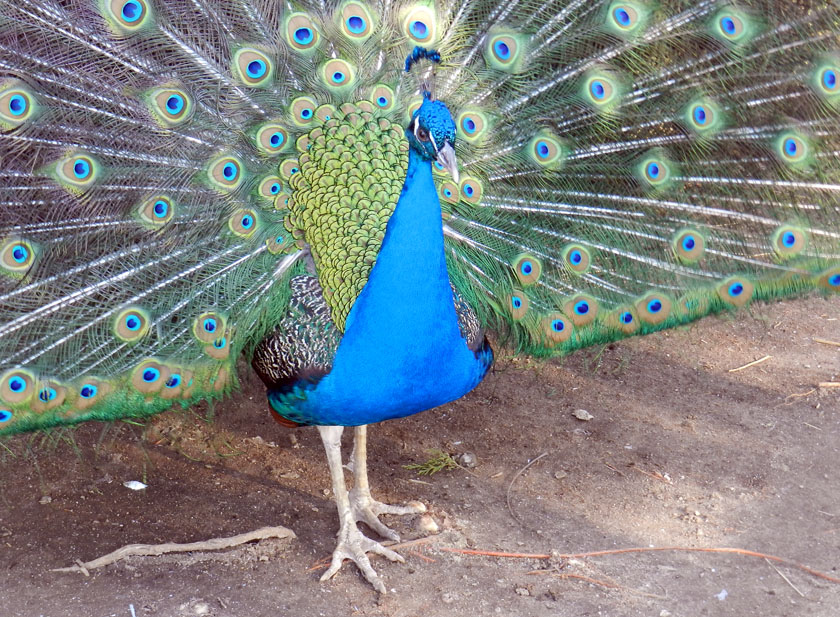 A peacock in a spacious enclosure just outside of Flannery O’Connor’s home, graciously displaying his tail feathers for us. See those feet? We’ll take a closer look at those soon. Photograph by Anthony Martin.
A peacock in a spacious enclosure just outside of Flannery O’Connor’s home, graciously displaying his tail feathers for us. See those feet? We’ll take a closer look at those soon. Photograph by Anthony Martin.
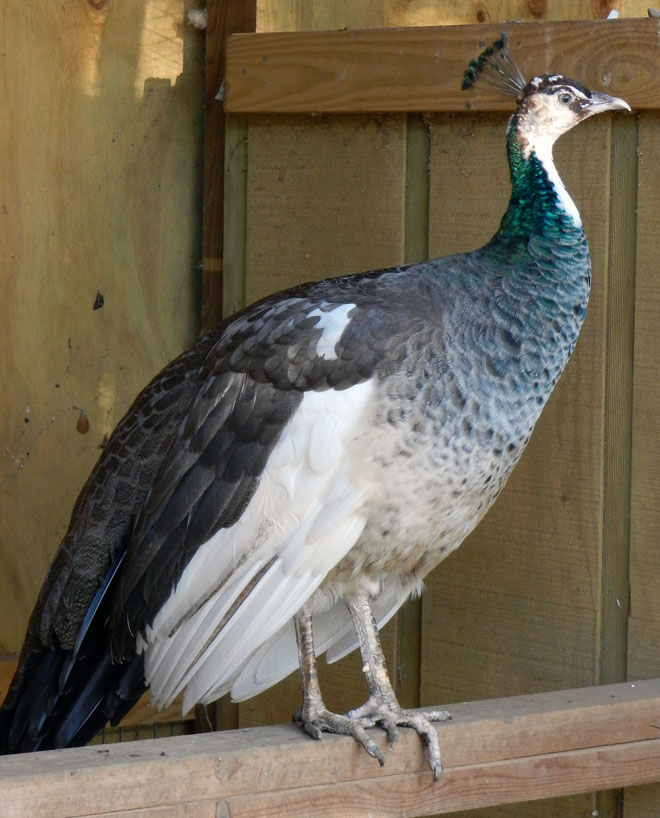 One of two peahens in the same enclosure, not nearly as resplendent and gaudy as her male companion, but still a very attractive bird. Of course, I was looking at her feet too, thinking about the tracks she would make, and how these might differ from those of the peacock. Photograph by Anthony Martin.
One of two peahens in the same enclosure, not nearly as resplendent and gaudy as her male companion, but still a very attractive bird. Of course, I was looking at her feet too, thinking about the tracks she would make, and how these might differ from those of the peacock. Photograph by Anthony Martin.
O’Connor’s earliest few minutes of fame were also bird-related, and established her life-long association with oddities of the South. When she was only five years old, she somehow taught a chicken to walk backwards. This feat attracted a film-reel company (Pathé News), which sent a crew from New York to Georgia to record this atypical avian mode of locomotion. The film reel, shown in theaters in 1932, also parodied O’Connor’s childhood accomplishment by reversing the film for other walking domestic animals, making these animals also appear to also walk backwards.
DO YOU REVERSE?
It’s one thing to read about Flannery O’Connor and her backwards-walking chicken, but it is another to actually see an original film about it. In the reel, she is mistakenly identified as “Mary O’Connor,” but no matter, as it was a start to her enduring fame for inventing quirky actions, plots, and characters reflecting the off-kilter cultures of her Southern environs. Incidentally, just how would you tell the difference between tracks made by a chicken moving forward or backwards? Maybe that should be the topic of a future post…
O’Connor’s link to paleontology was an oblique one, in that (as far as I know) she did not express any interest in it as a subject. Nonetheless, she was a great admirer of paleontologist, Jesuit priest, and philosopher Tielhard de Chardin, and the title of one of her anthologies, Everything That Rises Must Converge (1965), came directly from one of his writings. Also, in an “if only” moment of my own during my talk on O’Connor’s porch, I wondered what sort of fiction or essays would have come out of O’Connor had she lived long enough to learn that birds are actually living dinosaurs, and hence she had unwittingly surrounded herself with the progeny of those Mesozoic monsters.
Oh yes, my talk on O’Connor’s porch. How did that go? Fantastically. Because of the gorgeous weather that day, Craig Amason, my host and executive director of the Flannery O’Connor-Andalusia Foundation, thought that we might hold the discussion on the screened front porch, rather than inside in one of the more spacious rooms of the house. I was all for this idea, partially for its atmosphere (I mean, how cool would it be to talk about Flannery O’Connor with some of her fans on her front porch?), but also because we planned to have everyone walk on the trails with us later, looking for tracks and other traces of the animals that live there. Melanie and I had already scouted the trails in the morning and found a few surprises, so we knew that part of the program would be great fun, too: might as well get them halfway outside already by being on the porch. Fortunately, all of the dozen or so people who showed up also approved of this plan, which was helped in no small part by a heaping helping of cookies and soft drinks, enticing them to stay right there on the porch for a spell, and perhaps even relax in a rocking chair.
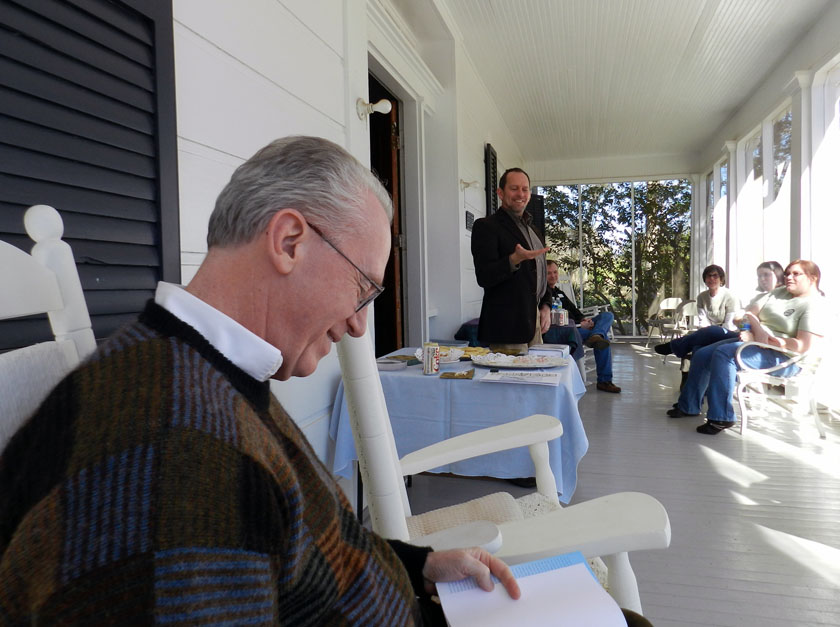 Dr. Bruce Gentry of Georgia College and State University, having just bought a copy of my book, opens it to take a look inside. Dr. Gentry is a scholar of Flannery O’Connor works and heads the Flannery O’Connor Studies Program at Georgia College and State University, in nearby Milledgeville. Meanwhile, I’m in the background, gesturing grandly to the delicious cookies on the table next to me while also introducing everyone to the topic of bird tracks and sign. Photograph by Melanie DeVore.
Dr. Bruce Gentry of Georgia College and State University, having just bought a copy of my book, opens it to take a look inside. Dr. Gentry is a scholar of Flannery O’Connor works and heads the Flannery O’Connor Studies Program at Georgia College and State University, in nearby Milledgeville. Meanwhile, I’m in the background, gesturing grandly to the delicious cookies on the table next to me while also introducing everyone to the topic of bird tracks and sign. Photograph by Melanie DeVore.
A sample of our front-porch chat about Flannery O’Connor and her birds, in which I point out the close resemblance between a rooster’s feet and those of a peacock. Although the peacock tracks would have been noticeable larger than those of her chickens, their overall forms would have been nearly the same, with three long thin toe-prints pointing forward, one shorter one pointing backward, and all four ending with clawmarks. Video footage by Craig Amason, exceutive director of the Andalusia-Flannery O’Connor Foundation.
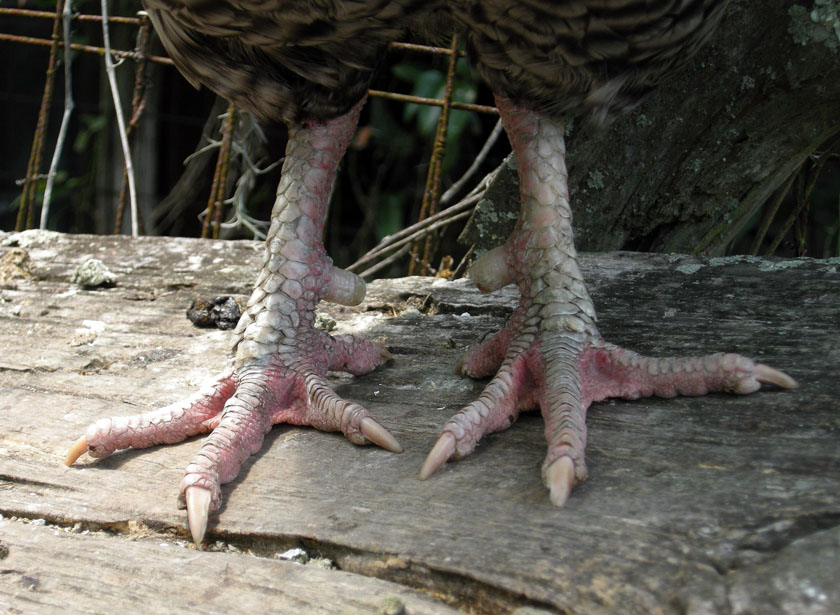 A close-up of a rooster’s feet. Think about the tracks this would produce, whether walking forward or backwards. Rooster was known as “Tom” (R.I.P.), formerly owned by Carol Ruckdeschel on Cumberland Island, Georgia. Photograph by Anthony Martin.
A close-up of a rooster’s feet. Think about the tracks this would produce, whether walking forward or backwards. Rooster was known as “Tom” (R.I.P.), formerly owned by Carol Ruckdeschel on Cumberland Island, Georgia. Photograph by Anthony Martin.
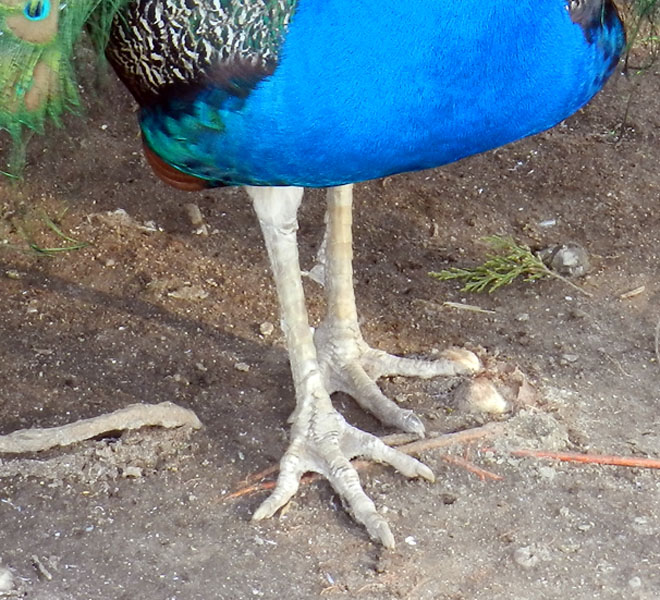 Now compare the rooster’s feet to those of this peacock at Andalusia Farm, and you’ll see for yourself how close they are to one another in their overall form, despite the rear digits being hidden in this photo. I could not help but think that O’Connor, while seeking the pleasure of the company provided by her birds, also saw thousands of similar-looking peacock and chicken tracks every day she went outside. Photograph by Anthony Martin.
Now compare the rooster’s feet to those of this peacock at Andalusia Farm, and you’ll see for yourself how close they are to one another in their overall form, despite the rear digits being hidden in this photo. I could not help but think that O’Connor, while seeking the pleasure of the company provided by her birds, also saw thousands of similar-looking peacock and chicken tracks every day she went outside. Photograph by Anthony Martin.
The talk itself was mercifully brief on such a fine day, with tracks and other sign awaiting us. So I simply expressed my gratitude for being there with all of us gathered in this special place, talked about Flannery O’Connor’s love of birds, and jumped into a speculative discussion of what tracks she might have seen every day on the farm. My presentation was decidedly low-tech, in which my only visual aids were paper print-outs of bird tracks and feet and a couple of my illustrations from the book, which were of bird-track categories and nests. These were supplemented by my acting out birds motions (walking, mostly), demonstrating how these behaviors would result in certain trackway patterns. One of these, much to the amusement of audience, was of a peacock doing its little circular and sideways-stepping dance, which was followed by my asking them to imagine the trackway patterns that would have resulted from such courting.
I also did a short reading from my book that introduces the topic of bird tracks, which fairly drips with admiration for the complexity of behaviors captured by such traces, thus hopefully echoing O’Connor enthusiasm for birds. Many questions were asked and observations of bird behavior offered, a give-and-take that I thoroughly enjoyed in the role of a “guide on the side” rather than a “sage on the stage” (or a “torch on the porch”). Once done, we had a short break for people to buy my book (thanks, y’all!), then walked onto a nearby trail to look at what the wild animals had left us the previous few days.
This outing was enjoyable, a bit of a treasure hunt and an eye-opening experience for many of how much animal activity is embodied by their traces in a typical Piedmont forest and its water bodies. Some of the traces I had seen earlier in the day while out scouting with Melanie, but we saw more, such as previously missed raccoon tracks and woodpecker sign. The highlights included the discovery of fresh (less than 12-hour-old) beaver tracks on one of the stream banks. This delighted several people, who told me that beavers had supposedly moved out of the area years ago, so they were pleased to know that at least one was back in the neighborhood. I was also excited to find coyote scat on the trail, which inspired earthy, amusing comparisons between the territorial markings of mammals in the wild versus those of corporate board members and academics (which, not surprisingly, are not so different in practice).
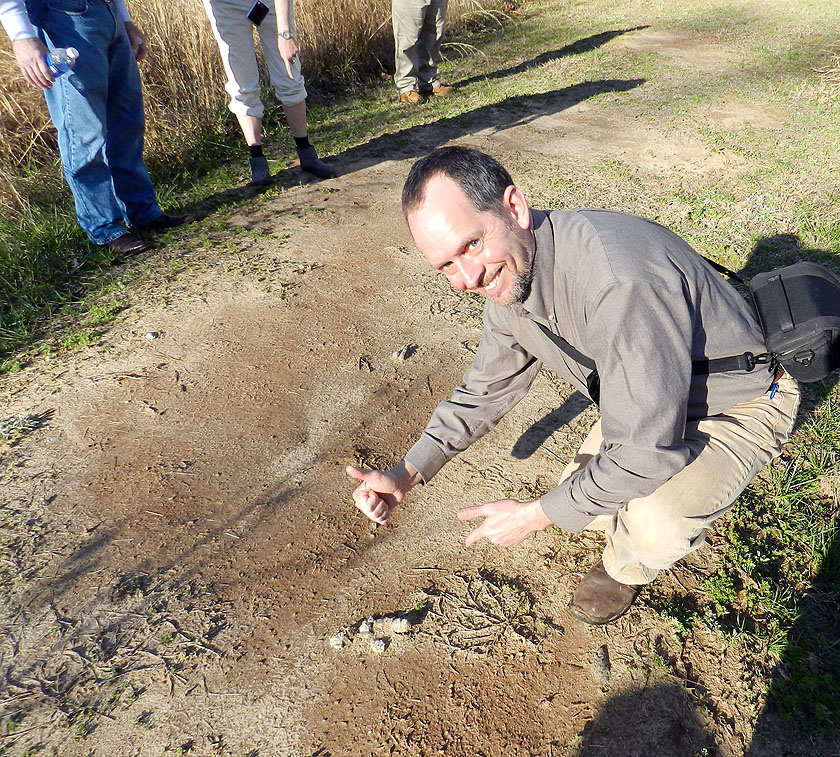 Coyotes just can’t help themselves: where we see a human footpath, they see an advertising opportunity. Here I excitedly point out an example of coyote scat, which had been strategically placed in the middle of the trail so that all other mammals would know this was her/his territory. You know, just like you might see happen in a professional meeting. Photograph by Melanie DeVore.
Coyotes just can’t help themselves: where we see a human footpath, they see an advertising opportunity. Here I excitedly point out an example of coyote scat, which had been strategically placed in the middle of the trail so that all other mammals would know this was her/his territory. You know, just like you might see happen in a professional meeting. Photograph by Melanie DeVore.
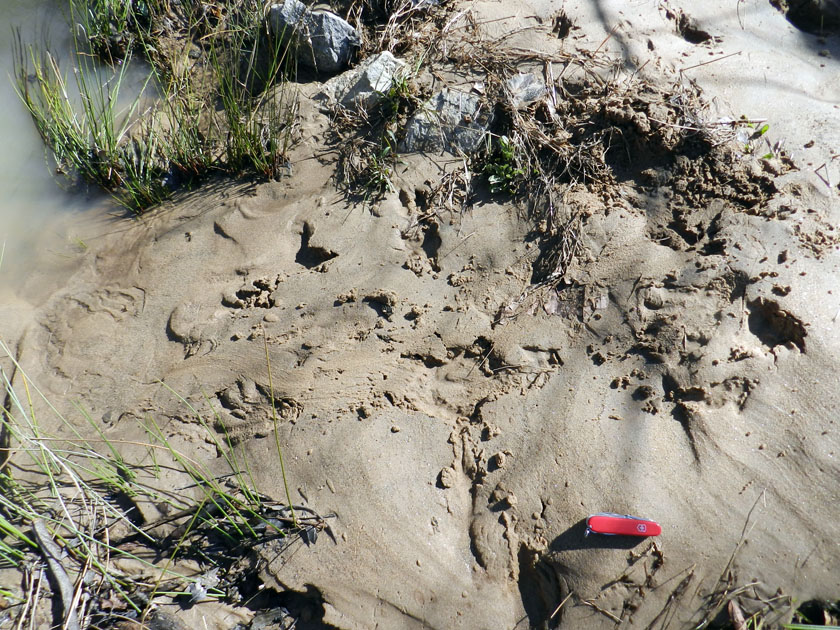 Fresh beaver tracks on a stream bank! This was a happy find, as it demonstrated that at least one beaver was in the area, following a nearly five-year absence of their species. These tracks show the beaver turned to its right and walked down the bank and into the water; look for the large rear-foot track to the left, and the tail dragmark in the middle. Swiss Army knife is about 6 cm (2.4 in) long. Photograph by Anthony Martin.
Fresh beaver tracks on a stream bank! This was a happy find, as it demonstrated that at least one beaver was in the area, following a nearly five-year absence of their species. These tracks show the beaver turned to its right and walked down the bank and into the water; look for the large rear-foot track to the left, and the tail dragmark in the middle. Swiss Army knife is about 6 cm (2.4 in) long. Photograph by Anthony Martin.
Once this short, ichnologically-infused hike was over, people thanked me and bid goodbye, but a few of stayed behind to take a gander at the peafowl, which were in a large enclosure just behind O’Connor’s house. One male and two females are kept there, and our timing was impeccable, as the male was in full display mode, feathers fully erect and dazzling as he strut about the grounds, while the peahens stayed in the background, mildly impressed or nonchalant. (“Oh yes, he does that all of the time,” I imagined them thinking, mildly bored.) Nevertheless, as far as we non-avian bipeds were concerned, he was indeed the king of birds.
But that’s when my ichnologist hat popped onto my head, askance from its sudden appearance. Craig had told me earlier about the peafowls making a dust bath in the confines of their enclosure, and sure enough, there it was. It matched the width, depth, and shape of dust baths I had written about in Life Traces of the Georgia Coast, only for wild turkeys. Birds make dust baths for alleviating skin parasites, in which they hunker down in them, using their wings to distribute enough fine-grained sediment on them to smother the offending lice or other arthropods. Could such traces preserve in the geologic record, whether they were made by feathered dinosaurs, birds, or mammals? How could we recognize or distinguish these from other shallow depressions? And most importantly, did Flannery O’Connor ever see such dips in the landscape, and if so, did she know their meaning?
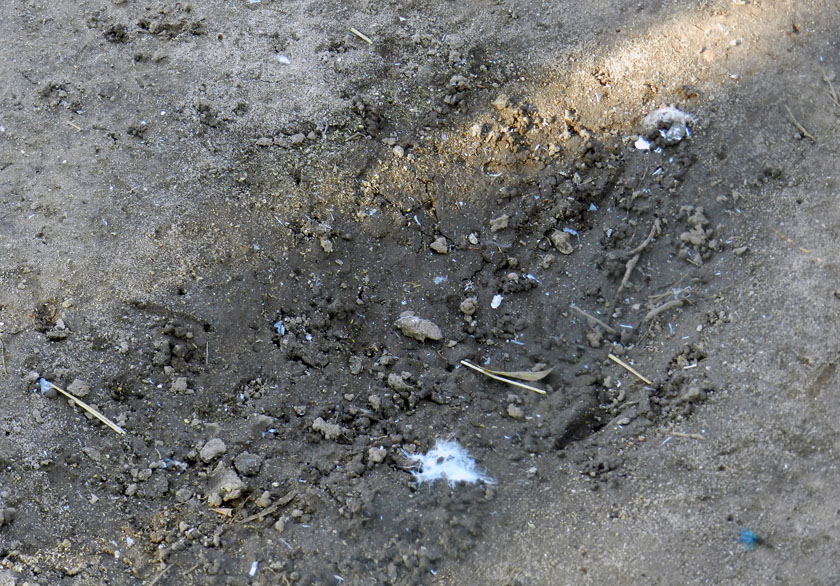 A dust bath made by peafowls, about 50 cm (20 in) wide on its longest dimension, and looking a little less dusty after several days of intense rain the preceding week. Still, this was a cool trace to see, and conjured some imaginative thoughts about these as trace fossils. (Peafowl feces extra in the pit: no charge.) Photograph by Anthony Martin.
A dust bath made by peafowls, about 50 cm (20 in) wide on its longest dimension, and looking a little less dusty after several days of intense rain the preceding week. Still, this was a cool trace to see, and conjured some imaginative thoughts about these as trace fossils. (Peafowl feces extra in the pit: no charge.) Photograph by Anthony Martin.
Another ichnologically inclined thought occurred to me while there at the enclosure, and is worthy of further experimentation. How might we tell the male (peacock) tracks from those of the female (peahen)? Take a look at the following photo, and you tell me. Anything there that might leave a distinctive mark identifying the gender of its tracemaker?
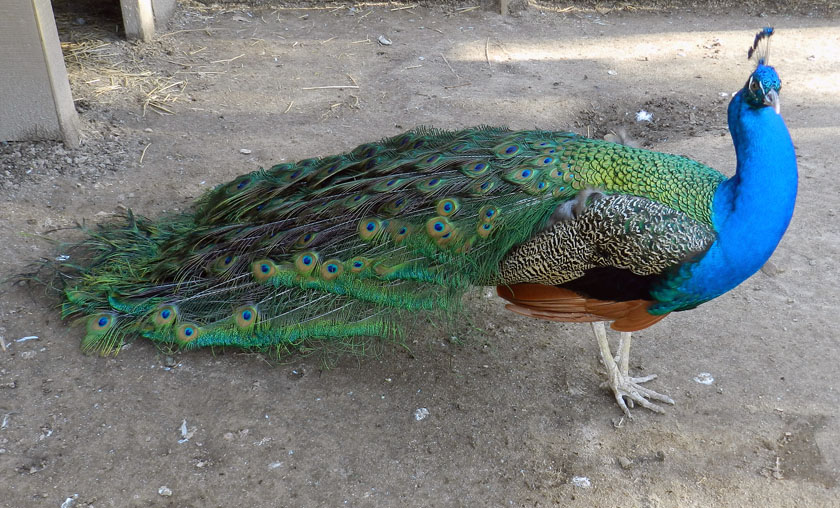 Here comes the groom! Any aspect of this tracemaker’s anatomy that might leave traces telling you he was a boy bird? Photograph by Anthony Martin.
Here comes the groom! Any aspect of this tracemaker’s anatomy that might leave traces telling you he was a boy bird? Photograph by Anthony Martin.
So from this day trip to Andalusia Farm, I was awed, inspired, and ever slightly more enlightened by it all, and hoped that a small amount of the same feelings had been experienced by others who participated in this special day. Still, I was also humbled, realizing how little I still know about Flannery O’Connor, why she connected so well with birds, bird traces and behavior, or how these traces might manifest themselves to us and grace us with wisdom as recognizable trace fossils made in a distant past. Hence from my time there and into my future, I will endeavor to keep in mind the words spoken by Dr. Block, a character of O’Connor’s in The Enduring Chill from the anthology, Everything That Rises Must Converge:
“Most things are beyond me,” Block said. “I ain’t found anything yet that I thoroughly understood.”
Acknowledgements: Many thanks to: my good and long-time friend Melanie DeVore for encouraging me to visit Andalusia to share my science and sense of wonder; Craig Amason for being such a gracious host; Bruce Gentry for his continuing contributions to teaching his students about the complex and varied dimensions of Flannery O’Connor, a great American writer; the people who showed up and made for lively company; and of course the birds and their traces, which will outlive all of us, no matter the lengths of our lives.
Further Reading
Elbroch, M. and Marks, E. 2001. Bird Tracks and Sign of North America. Stackpole Books: 456 p.
Martin, A.J. 2013. Life Traces of the Georgia Coast: Revealing the Unseen Lives of Plants and Animals. Indiana University Press: 692 p.
O’Connor, F. 1955. A Good Man is Hard to Find, and Other Stories. Harcourt, Brace and Company: 265 p.
O’Connor, F. 1965. Everything That Rises Must Converge. Farrar, Straus and Giroux: 320 p.
Simpson, M. 2005. Flannery O’Connor: A Biography. Greenwood Books: 152 p.

